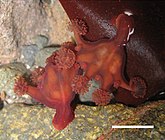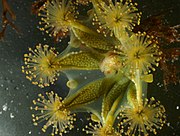| Staurozoa Temporal range: Late Ediacaran—Recent PreꞒ Ꞓ O S D C P T J K Pg N | |
|---|---|

| |
| Haliclystus stejnegeri | |
| Scientific classification | |
| Domain: | Eukaryota |
| Kingdom: | Animalia |
| Phylum: | Cnidaria |
| Subphylum: | Medusozoa |
| Class: | Staurozoa Marques & Collins, 2004 |
| Orders | |
| |
Staurozoa is a class of Medusozoa (or jellyfish). It has one extant order: Stauromedusae (stalked jellyfishes) with a total of 50 known species. A fossil group called Conulariida has been proposed as a second order, although this is highly speculative. The extinct order is largely unknown and described as a possibly cnidarian clade of marine life with shell-like structures, the Conulariida. Staurozoans are small animals (1–4 cm or 0.4–1.6 in) that live in marine environments, usually attached to seaweeds, rocks, or gravel. They have a large antitropical distribution, a majority found in boreal or polar, near-shore, and shallow waters. Few staurozoans are found in warmer tropical and subtropical water environments of the Atlantic, Indian, and Pacific Ocean basins, but most are known from the Northern Hemisphere. Over the years the number of discovered species has increased, with an estimated 50 species currently recognized. Information on Staurozoa is sparse, and it is one of the least studied groups within Cnidaria. While often neglected, correctly recognizing the characteristics of this class is crucial for understanding cnidarian evolution.
Morphology
Their life cycle is not well known, but is simplistic. They have a lifespan of less than a year and the planua larva attaches to the substrate, developing into a primary (interstitial) polyp that undergoes an apical transformation to develop into its adult body. The bodies consist of a calyx or cup, where they take in their prey with tentacles that contain cnidocysts (stinging cells). The tentacles are clusters on the edge of the body that lie on a stalk that attaches to a benthic substrate with their adhesive basal disk. The color of a Staurozoan depends on where they've attached in their environment.
Ecology
Staurozoans are predators. Their diet includes crustaceans, with smaller Staurozoans consuming harpacticoid copepods and larger species consuming gammarid amphipods. They also eat chironomid fly larvae and plankton. After digestion, they eject the remains of their food from their bodies. They are also preyed upon by fish as well as mollusks.
Gallery
References
- Liu, A. G.; Matthews, J. J.; Menon, L. R.; McIlroy, D.; Brasier, M. D. (22 October 2014). "Haootia quadriformis n. gen., n. sp., interpreted as a muscular cnidarian impression from the Late Ediacaran period (approx. 560 Ma)". Proceedings of the Royal Society B: Biological Sciences. 281 (1793): 20141202. doi:10.1098/rspb.2014.1202. PMC 4173675. PMID 25165764.
- McIlroy, D.; Pasinetti, G.; Pérez-Pinedo, D.; McKean, C.; Dufour, S. C.; Matthews, J. J.; Menon, L. R.; Nicholls, R.; Taylor, R. S. (September 2024). "The Palaeobiology of Two Crown Group Cnidarians: Haootia quadriformis and Mamsetia manunis gen. et sp. nov. from the Ediacaran of Newfoundland, Canada". Life. 14 (9): 1096. doi:10.3390/life14091096. ISSN 2075-1729. PMC 11432848.
- Marques and Allen (2004). "Cladistic analysis of Medusozoa and cnidarian evolution". Invertebrate Biology. 123 (1): 23–42. doi:10.1111/j.1744-7410.2004.tb00139.x. Retrieved 29 September 2020.
- ^ Collins, A. G. (n.d.). Staurozoa. AccessScience. doi:10.1036/1097-8542.652700
- Miranda, Lucília S.; Mills, Claudia E.; Hirano, Yayoi M.; Collins, Allen G.; Marques, Antonio C. (2018-12-01). "A review of the global diversity and natural history of stalked jellyfishes (Cnidaria, Staurozoa)". Marine Biodiversity. 48 (4): 1695–1714. doi:10.1007/s12526-017-0721-4. ISSN 1867-1624. S2CID 11242035.
| Extant Cnidaria classes | ||
|---|---|---|
| Anthozoa |  | |
| Medusozoa | ||
| Myxozoa | ||
| Taxon identifiers | |
|---|---|
| Staurozoa | |
This subphylum Medusozoa-related article is a stub. You can help Misplaced Pages by expanding it. |


